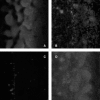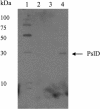PslD is a secreted protein required for biofilm formation by Pseudomonas aeruginosa
- PMID: 16598021
- PMCID: PMC1448989
- DOI: 10.1128/AEM.72.4.3066-3068.2006
PslD is a secreted protein required for biofilm formation by Pseudomonas aeruginosa
Abstract
The function of pslD, which is part of the psl operon from Pseudomonas aeruginosa, was investigated in this study. The psl operon is involved in exopolysaccharide biosynthesis and biofilm formation. An isogenic marker-free pslD deletion mutant of P. aeruginosa PAO1 which was deficient in the formation of differentiated biofilms was generated. Expression of only the pslD gene coding region restored the wild-type phenotype. A C-terminal, hexahistidine tag fusion enabled the identification of PslD. LacZ and PhoA translational fusions with PslD indicated that PslD is a secreted protein required for biofilm formation, presumably via its role in exopolysaccharide export.
Figures


References
-
- Babu, M. M., and K. Sankaran. 2002. DOLOP-database of bacterial lipoproteins. Bioinformatics 18:641-643. - PubMed
-
- Cserzo, M., E. Wallin, I. Simon, G. von Heijne, and A. Elofsson. 1997. Prediction of transmembrane alpha-helices in prokaryotic membrane proteins: the dense alignment surface method. Protein Eng. 10:673-676. - PubMed
-
- Daniels, C., C. Vindurampulle, and R. Morona. 1998. Overexpression and topology of the Shigella flexneri O-antigen polymerase (Rfc/Wzy). Mol. Microbiol. 28:1211-1222. - PubMed
Publication types
MeSH terms
Substances
LinkOut - more resources
Full Text Sources
Molecular Biology Databases

